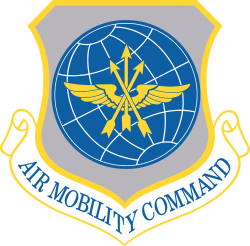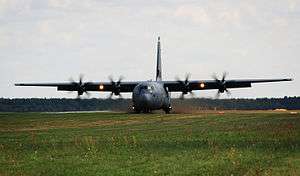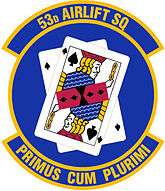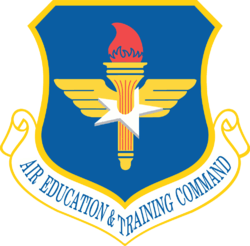53d Airlift Squadron
53d Airlift Squadron
 | |
|---|---|
 C-130J Super Hercules lands on an unimproved runway | |
| Active | 1942–1945; 1946–1966; 1972–1993; 1993–present |
| Country |
|
| Branch |
|
| Role | Airlift |
| Part of | Air Mobility Command |
| Garrison/HQ | Little Rock Air Force Base |
| Nickname(s) | Blackjack |
| Motto(s) | Primus Cum Plurimi Latin First with the Most[1] |
| Engagements |
European Theater of Operations Mediterranean Theater of Operations Korean War[1] |
| Decorations |
Distinguished Unit Citation Air Force Outstanding Unit Award Republic of Korea Presidential Unit Citation Republic of Vietnam Gallantry Cross with Palm[1] |
| Insignia | |
| 53d Airlift Squadron emblem (approved 10 September 1953)</ref>[1][note 1] |
 |
The 53d Airlift Squadron is part of the 19th Airlift Wing at Little Rock Air Force Base, Arkansas. It operates Lockheed C-130 Hercules aircraft for airlift and airdrop operations.
History
World War II
Activated in June 1942 as a I Troop Carrier Command Douglas C-47 Skytrain troop carrier squadron, trained in the United States. Assigned to Twelfth Air Force and deployed North Africa during May 1943. The squadron's aircraft flew supplies to front-line units in Algeria and Tunisia during the North African Campaign as soon as suitable landing strips were available and evacuated casualties back to rear area field hospitals.
Squadron engaged in combat operations, dropping airborne units into Sicily during the Operation Husky invasion and later into areas around Anzio, Italy as part of Operation Shingle, the invasion of mainland Italy and the initiation of the Italian Campaign, January 1944. Moved north though Italy, in 1943 in support of Allied ground forces, evacuated wounded personnel and flew missions behind enemy lines in Italy and the Balkans to haul guns, ammunition, food, clothing, medical supplies, and other materials to the partisans and to drop propaganda leaflets.
Was moved to England in February 1944, assigned to IX Troop Carrier Command. Prepared for the invasion of Nazi-occupied Europe. In June 1944, subordinate units dropped paratroops in Normandy, subsequently flying numerous missions to bring in reinforcements and needed supplies. During the airborne attack on The Netherlands (Operation Market Garden, September 1944), the squadron dropped paratroops, towed gliders, and flew resupply missions. Several of its subordinate units also participated in the invasion of southern France in August 1944. The 50th supported the 101st Airborne Division in the Battle of the Bulge by towing gliders full of supplies near Bastogne on 27 December 1944.
When the Allies made the air assault across the Rhine River in March 1945, each aircraft towed two gliders with troops of the 17th Airborne Division and released them near Wesel. The squadron also hauled food, clothing, medicine, gasoline, ordnance equipment, and other supplies to the front lines and evacuated patients to rear zone hospitals.
In late May 1945, after V-E Day, the squadron was moved to Waller Field, Trinidad and attached to Air Transport Command. From Trinidad, the squadron ferried returning military personnel to Morrison Field, Florida, where they were sent on to other bases or prepared for separation after the war.
Berlin airlift
The squadron participated in the Berlin Airlift, 1948–1949.
Korean war
It conducted aerial transportation from the U.S. to Japan from August–December 1950, and between Japan and Korea from 13 December 1950 – November 1952.
Airlift operations
It conducted worldwide airlift operations from 1953 to 1966, including resupply to Antarctica from 1957 to 1958, and missions to Southeast Asia during the Vietnam War. The 53d again conducted worldwide airlift from 1972 to 1993 flying missions into Grenada, 23 October 1983 – 9 November 1983, during the invasion of Panama, 20 December 1989, and to Southwest Asia, August 1990 – June 1991. The squadron was inactivated in 2008 and detached from AETC. It was reactivated in October 2008 as a part of the 19th Airlift Wing.
Lineage
- Constituted as the 53d Transport Squadron on 30 May 1942
- Activated on 1 June 1942
- Redesignated 53d Troop Carrier Squadron on 4 July 1942
- Inactivated on 31 July 1945
- Activated on 30 September 1946
- Redesignated 53d Troop Carrier Squadron, Medium on 1 July 1948
- Redesignated 53d Troop Carrier Squadron, Heavy on 15 August 1948
- Redesignated 53d Military Airlift Squadron on 8 January 1966
- Discontinued and inactivated on 8 July 1966
- Activated on 8 January 1972
- Redesignated 53d Airlift Squadron on 1 January 1992
- Inactivated on 30 April 1993
- Activated on 1 October 1993
- Inactivated on 11 January 2008
- Activated on 15 May 2008[1]
Assignments
- 61st Transport Group (later 61st Troop Carrier Group), 1 June 1942 – 31 July 1945
- 61st Troop Carrier Group, 30 September 1946 (attached to Airlift Task Force, Provisional, August 1958 – February 1959, February–July 1960, and 5 January 1961 – April 1962)
- 63d Troop Carrier Group, 8 October 1959
- 63d Troop Carrier Wing (later 63d Military Airlift Wing), 18 January 1963 – 8 July 1966
- 63d Military Airlift Wing, 8 January 1972
- 63d Military Airlift Group, 1 October 1978
- 63d Military Airlift Wing, 1 July 1980
- 63d Operations Group, 1 January 1992 – 30 April 1993
- 314th Operations Group, 1 October 1993 – 11 January 2008
- 463d Airlift Group, 15 May 2008 – 1 October 2008
- 19th Operations Group, 1 October 2008 – present[1]
Stations
|
|
Aircraft
|
|
References
Notes
- Explanatory notes
- ↑ On 9 December 1994, the emblem was modified to reduce the width of the yellow border and revise the tabs. Robertson, Maurer, Combat Squadrons, p. 222. The squadron used the emblem during World War II (without tabs and with an orange border), but it is not known if this version was approved. Watkins, p. 64
- Citations
Bibliography
![]()
- Maurer, Maurer, ed. (1983) [1961]. Air Force Combat Units of World War II (PDF) (reprint ed.). Washington, DC: Office of Air Force History. ISBN 0-912799-02-1. LCCN 61060979. Retrieved December 17, 2016.
- Maurer, Maurer, ed. (1982) [1969]. Combat Squadrons of the Air Force, World War II (PDF) (reprint ed.). Washington, DC: Office of Air Force History. ISBN 0-405-12194-6. LCCN 70605402. OCLC 72556. Retrieved December 17, 2016.
- Ravenstein, Charles A. (1984). Air Force Combat Wings, Lineage & Honors Histories 1947-1977 (PDF). Washington, DC: Office of Air Force History. ISBN 0-912799-12-9. Retrieved December 17, 2016.
- Watkins, Robert (2008). Battle Colors. Vol III Insignia and Markings of the Ninth Air Force In World War II. Atglen, PA: Shiffer Publishing Ltd. ISBN 978-0-7643-2938-8.


.svg.png)